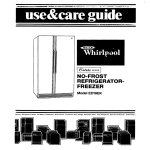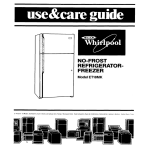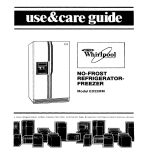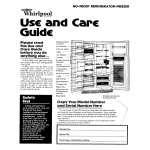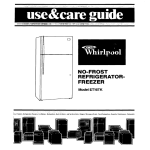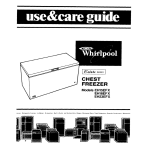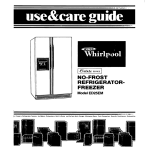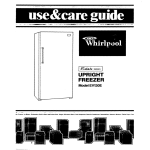Download NO-FROST REFRIGERATOR- FREEZER
Transcript
NO-FROST REFRIGERATORFREEZER Model ETl8MK CAVE rd. Freezers. Refrigerator-Freezers, ‘sL-8 ~~ ,;?; -j :“~.-,.i-*?,: .,.e> .:*< m.+ g;,i:?c &.ce-%; -a-, ~b ,&..:**.:. ; Ice Makers, Dishwashers, Bmlt-In Ovens and Surlace Units. Ranges, MIcrowave Ovens. Trash Compactors, Room Air Condltloners. Oehumldlllel Please read this Use and Care Guide before you do anything else... This booklet tells you how to start your refrigerator, clean it, move shelves and adjust controls. It even tells you what new sounds to expect from your refrigerator. Treat your new refrigerator with care. Use it only to do what home refrigerators are deslgned to do. Parts and features \ Freezer Control - Adjustable Freezer Shelf Utility Compartment Butter Compartment Meat Pan y Crisper / Crispen Copy your Model and Serial Numbers here... When you need service or call with a question. have this information ready: 1. Complete label located Model and Serial as shown). Numbers Model Number (from the Serial Number 2. Purchase date from sales slip. Purchase Copy this information in these spaces, Keep this book, your warranty and sales slip together in a handy place, 2 Service Date Company and Telephone Cover Number Contents Page 3 SAFETYFIRST BEK)REYOUPLUGITIN.. Ice Cube Trays Optional Automatic Ice Maker Sounds you May Hear Energy Saving Tips Install Properly. Level Refrigerator-Freezer Remove Sales Labels Clean It Plugltln , CLEANINGYOUR REFRIGERATOR Cleaning Chart FOOD STORAGE GUIDE USING YOUR REFRIGERATOR Setting the Controls Changing the Control Settings Power Saving Control Changing the Light Bulb Moving the Meat Pan and Cover Adjusting the Refrigerator Shelves Removing the Crispers and Cover Removing and Adjusting the Freezer Shelf Storing Fresh Food Freezing and Storing Frozen Foods VACATION AND MOVING CARE IF YOU NEED SERVICE OR ASSISTANCE I. 2. 3. 4. Before Calling for Assistance If You Need Assistance If You Need Service If You Have a Problem.. Page 7 7 8 8 8 9 10 10 11 14 15 15 15 15 15 7 01986 Whirlpool Corporation Before you plug it in IMPORTANT Before using your refrigerator, you are personally responsible for making sure that it... l is installed and leveled on a floor that will hold the weight, and in an area suitable for its size and use. l is connected only to the right kind of outlet, with the right electrical supply and grounding. [Refer to your “Electrical Requirements and Grounding Instructions:‘) l is used only for jobs expected of home refrigerators is not near an oven, radiator or other heat source. is properly maintained. is out of the weather is used in an area where the room temperature will not fall below 55” F (13” C). . is not used by those who may not understand how it should be used. . is not loaded with food before it has time to get properly cold. 3 Install properly.. . Remove sales labels.. . Remove the Consumer Buy Guide label, tape and any Inside labels before using the refrigerator To remove any remaining glue: I, Rub briskly with thumb to make a ball then remove. OR 2. Soak area with dishwashing detergent solution (1 teaspoon detergent in 1 quart warm water] before removing glue as described in step I. DO NOT USE rubbing alcohol or flammable or toxic solvents, such as acetone, gasoline, carbon tetrachlorlde, etc. These can damage the material. NOTE: DO NOT REMOVE ANY PERMANENT INSTRUCTION LABELS INSIDE YOUR REFRIGERATOR. Do not remove the Tech Sheet fastened under the refrigerator at the front. Clean it.. . 1. Allow 3 inches (7.5 cm) between overhead cabinets and refrigerator top. 2. Allow at least an inch (2.5 cm) between the refrigerator condenser on the back and the wall. 3. Allow ‘/2 inch (1.25 cm) on each side of the refrigerator for ease of installation, 4. If the refrigerator is to be against a wall, you might want to leave extra space on the hinge side so the door can be opened wider, .- ., ‘-.-*,s 2IIR%,1 . .‘. ‘.I *I .:...-seil -F~~rFiE Level refrigerator-freezer.. Clean your refrigerator before using it. See cleaning instructions on page 9 Plug it in... 3-prong grounding type wall receptacle . II Leveling Use Screwdriver to Adjust screw Raise Right to Raise; Left to Lower Refrigerator Power Cord RECOMMENDED 1. To raise front, turn each screw to the right 2. To lower front. turn each screw to the left 3. Check with level. GROUNDING METHOD A 115 Volt, 60 Hz., AC only 15 or 20 ampere fused and properly grounded electrical supply is required. It is recommended that a separate circuit serving only this appliance be provided. Do not use an extension cord. Use a receptacle which cannot be turned off with a switch or pull chain. See individual electrical requirements and grounding ature package. 4 instruction sheet in your liter- Using your Refrlgeratbr Control Power SavingControl Freezer Light Switch kontrol Setting the controls.. . Controls foe the refrigerator and freezer are in the refrigerator. When the refrigerator is plugged in foe the first time... 1. Set the REFRIGERATOR CONTROL to 3. Glve the refrigerator pletely before adding These settings should be about right household refrigerator usage. for nOrmal The controls will be set about right when milk or juice is as cold as you like and when ice cream is firm. 2. Set the FREEZER CONTROL to B. If you need to adjust temperatures in refrigerator 01 freezer, use the settings listed in the chart below. l l l CONDITION: If Refrigerator Section is TOO WARM If Freezer Section is TOO WARM QUESTIONS 3 tlme to cool down comfood. (This may take sev- Adjust the Refrigerator Control first. Wait at least 24 hours between adjustments. Then adjust the Freezer Control, if needed. RECOMMENDED CONTROL SETTINGS: REASONS: LReiri,g;;& ‘I j = v-v.,,-I.&I <se‘. IIY.P16~1~-.~llliLI:~.~ il. :,-zjEi>. ._ Door opened often Freezer Large amount of food added Room temperature too warm ~z.-.%-i~ --->--a-,. Refrigerator’ ‘.’ Door opened often Freezer Large amount of food added Very cold rmm temperature [can’t cycle often enouahl i w&a,a,%Aw xl”,i.m - : :: 221X. .msf&oJa,w,,.~a;~.~~.~-.,; Refrigerator Controls not set cofrectly Freezer for your conditions ...Cal’ your If Refrigerator COOL-LINEK Section is service TOO COLD assistance If ICE isn’t telephone MADE FAST ENOUGH number (page 151. If BOTH SECTIONSare TOO WARM il-.~~.~_“wYs.~~ -I I_L-d.L1 vlrl~*.-z,7k_LIIIIzd~7.. I ,a, ,,1I Heavy ice usage Very cold room temperature [can’t cycle often enough) *w~~~~~x~~ Door opened often Large amount of food added Very warm or very cold room temperatures .~_-_-_-.~.-__)i~.l_.,~. . .slyee..e.LY%.. __-I_u_jcn_~-/,,.~~.,,~~~~~~-= .-u, K__*...>-.Ts:L j I. i ..a d ~-_ Refrige;J& ..4r :* I ..lLC> Freezer -x‘&_. -I..~ ., : _.,m Refrigerator Freezer r-*-t .- _ L~.-L i%rn.UliY ,..--5A”EP -- POWEP .~ -... Power Saving Control.. . The Power Savlng Control on the Control Console operates electric heaters around the door openings. These heaters help keep moisture from forming on the outside of the refrigerator. 1, Use the “CONSUMES LESS ENEORGY” setting when humidity is low. 2. Use the “REDUCES EXTERIOR MOISTURE” setting only if moisture forms on tl 18 outside of the refrigerator. Changing the light bulb.. . WARNING: Betore removing the light bulb, either unplug the refrigerator or disconnect the electricity leading to the refrigerator at the maln power supply. Shock and injury can occur it electrfclty remains connected. 1. Reach behind control console to find bulb 2. Remove bulb. 3. Replace with a 40-w&t appliance bulb. Moving the meat pan and cover... Pull Out to Stop. Litt the Front and Pull AgaIn. Glass is heavy. Be Caretul. Removlng the Meat Pan: I. 2. 3. 4. Slide the meat pan out to stop. Lift the front. Slide pan the rest of the way out. Replace in reverse order. Removlng the cover: I, Push up glass insert from bottom, then slide out with both hands. 2. Lift cover frame out of frame support. 3. Tilt front of frame support up, lift at back, and pull support straight out. 4. Replace in reverse order Cover Frame Frame support Adjusting the refrigerator shelves... Shelves can be adjusted to match the way you use your refrigerator. Glass shelves are strong enough to hold bottles, milk and other heavy food items. To remove glass shelves: 1. Tilt up at front. 2. Lift up at back. 3. Pull shelf straight out. lo replace: 1. Guide the rear hooks into the slots in the shelf supports. 2. Tilt up front of shelf until hooks drop into slot. Lower front of shelf to level position. Gloss shelves are heavy Be careful. Removing crispers and crisper cover... Pull Out to Stop. Litt the Front Removing the Crispers: 1. Slide crisper straight out to stop, lift front, then slide the rest of the way out. 2. Replace in the reverse order Removing Cover: 1. Push up glass insert from bottom, then slide out with both hands. 2. Lift front of cover frame and remove cover support. 3. Lift out cover frame by pulling up and out. Replacfng ront, 6 Cover: 1. Fit back of cover into notch supports on walls of refrigerator, then lower front into place. 2. Replace cover support with the long tab towards the front. Note: If the support needs adjustment, turn base right to raise, or left to lower. 3. Slide back of glass insert into place, then lower front. Removing and adjusting the freezer To remove shelf: 1. Lift front slightly 2. Lift back off supports. 3. Replace in reverse order To adjust shelf: 1. 2. 3. 4. Remove shelf. Remove supports by sliding upwards. Replace supports on desired level. Replace shelf. Ice cube trays.. . To remove ice: If cubes are not used, they may shrink. The moving cold air starts a slow evapotction. The longer cubes are stated, the smaller they get. Optional automatic ice maker.. . If you have the automatic ice maker accessory or plan to add one later [Part No. ECKMF-83), there are a few things you will want to know: l The ON/OFF lever is a wire signal arm. Down., .for making ice automatically; Up...toshut off the ice maker. l Shake the bin occasionally to keep cubes separated, and to obtain increased storage capacity. l It is normal for ice crescents to be attached by a corner. They will break apart easily. On 1. Hold tray at both ends. 2. Slightly twist. l l l l l l l Lower Signal Arm to Start it. \ Raise Signal I Arm to Stop ice Maker. Ycu will hear water running when ice maker is working. You’ll hear ice fall into the bin. Don’t let these sounds bother you. The ice maker will not operate until the freezer is cold enough to make ice. This can take overnight. Because of new plumbing connections, the first ice may be discolored of off-flavored Discard the first few batches of ice. If ice is not being made fast enough and more ice is needed, turn the Refrigerator Control toward a higher number. Wait a day and, if necessary, turn the Freezer Control toward A. If you remove the ice bin, raise the signal arm to shut off the ice maker. When you return the bin. push it all the way in and lower the arm to the ON position. If cubes are stored too long, they may develop an off-flavor...like stale water. Throw them away. They will be replaced. Cubes in the ice bin can also become smaller by evaporation. Good waterquality is important for good ice qUalitV It is not recommended that the ice maker be connetted to a softened water supply. Water softener chemicals such as salt from a malfunctioning softener can damage the ice maker mold and lead to poor quality ice. If a softened water supply cannot be avoided, then it is important that the water softener be well maintained and operating properly. Sounds you may hear.. . ‘A P 3’ ,\\- Possible ‘iounds: l l l l l ’ Your new refrigerator may make sounds that your old one didn’t. Because the sounds are new to you, you might be concerned about them. Don’t be. Most of the new sounds are normal. Hard surfaces like the floor, walls and cabinets can make the sounds seem louder. The following chart describes the kinds of sounds that might be new to you, and what may be making them. “.,“,m.T-.-71.- i 7- .-~~-a.----.~ u?>F-w-e c,-l_,.“~mawUxJ*e ., .. . “’ ‘f’robable Causes: Slight Hum, Soft Hiss: You may hear the refrigerator’s fan motor and moving air. ,>e-..j ,,..__ Jr_/,lils..eeiA. .- I c * r__is..,-_Ir.i-.i_li~~~~L~=-~l I,y=~,.13i,--.~li=Ur~i-. :_yl,x-x.-&-Ez The defrost timer makes a definite click when the refrigerator stops running. It Clicking or Snapping also makes a sound when the refrigerator starts. Sounds: i- -Fe--.r*,. ,,a ,5-4e.a II Ili-*Lr--B_-&I..I - .~- -ccle____m5.-w/ ,.:3 .r. ., e.-,._ii-Water Sounds: When the refrigerator stops running, you may hear gurgling in the tubing for a few minutes after it stops, You may also hear defrost water running into the defrost water pan. e_L.a:, ,I-- y m--x L+iv>.I *“kz,-_uwl * r-w%.. IT.-b-mm .J I 3-i, . 1 Ice Maker Sounds: If your refrigerator has an ice maker, you may hear buzzing (from the water -trickling water valve), trickling water and the clatter of ice dumped into the bin. -thud (clatter of ice) . Irk.*.___ <*--,s_ I c-.pwI.,IY -m-._.. r-.ei-_c__ -,._ ..I_~,* Ij.i.rc*c ^(. ., , ,a. Your refrigerator has a high-efficiency compressor and motor. It will run longer Running Sounds: than older designs. It may even seem to run most of the time. Energy saving tips... You can help your refrigerator use less electricity Check door gaskets for a tight seal. Level the cabinet to be sure of a good seal. l Clean the condenser coil regularly. l Open the door as few times as possible. Think about what you need before you open the door. Get everything out at one time. Keep foods organized so you won’t have to search for what you want. Close door as soon as food is removed. l Go ahead and fill up the refrigerator, but don’t overcrowd it so air movement is blocked. l l Cleaning your refrigerator Both the refrigerator and freezer sections defrost automatically. But both should be cleaned about once a month to help prevent odors from building up. Of course, spills should be wiped up right away. TO clean your refrigerator, turn the Refrigerator Control to OFF, unplug it, take out all removable parts, and clean it according to the following directions. l l It is a waste of electricity to set the refrigerator and freezer to temperatures colder than they need to be. If ice cream is firm in the freezer and drinks are as cold as your family likes them, that’s cold enough. Keep the Power Saving Control on CONSUMES LESS ENERGY unless moisture forms on refrigerator exterior Make sure your refrigerator is not next to a heat source such as a range, water heater, furnace, radiator, or in direct sunlight. Cleaning chart... ax I-lm-P.-.-s Part What to use Removable parts [shelves, crisper, meat pan etc.) Sponge or cloth: mild detergent and warm water. Outside Sponge, cloth or paper towel; mild detergent; appliance wax [or good auto paste wax). How to clean .- Wash removable parts with warm water and a mild detergent. Rinse and dry l l Wash with warm water and a mild detergent. Do not use abrasive or harsh l cleansers. Rinse and dry Wax painted metal surfaces at least twice a year with appliance wax or a good auto paste wax. Apply wax with a clean, soft cloth. Do not use wax l l on plasttc parts. Waxing painted metal surfaces provides rust protection. il.Wash with warm water and -mild detergent or -baking soda (2 tablespoons [26 gl to 1 quart [ .95 I] warm water. l Rinse and dry w.-av_.e..m.*--I*n.wPmlt-al Wash with mild detergent and warm Sponge, soft cloth or paper towel; mild water. l Rinse and dry detergent, warm water. Inside walls (Freezer should be allowed to warm up so cloth won’t stick.) Sponge, sofi cloth or paper towel, baking soda, warm water, mild detergent. Door liners and gaskets l DO NOT USE Cleaning waxes, concentmted detergents, bleaches or cleansers containing petroleum on plastic parts. _PC,m_B-.v Dark plastics (covers and panels) -+ Mild detergent and warm water; soft, clean sponge and soft, clean cloth. l l Wash with a soft grit-free cloth or sponge. Rinse and dry with a damp grit-free cloth or chamois. DO NOT USE paper towels, window spmys, scouring cleansers, or flammable or toxic solvents like acetone, gasoline, carbon tetmchlorlde, etc. These can scratch or damage the material. ~-,-u~.m~. -ijr Defrost pan [behind refrigerator on top of the motor) -Sponge or cloth: mild detergent and warm water. l l Roll refrigerator out away from wall. Wash defrost pan with warm water and mild detergent. Do not remove defrost pan to clean. Rinse and dry Roll refrigerator back into place. ---_/-a.-w~ ____w-,.# :.r -r;.ll~~~~wwLm~~~~ uL-“.I--.l Clean dust and lint from condenser Condenser coils Use vacuum cleaner coils behind the refrigerator at with brush attachment. least once every other month. l Leave an inch 12.54 cm) between wall and condenser coils on back of the refrigerator. - .<I/--Y :-“-*x i W.rzs~_~~ -e-T l,lU u l Roll refrigerator out away from wall. Floor under refrigerator Usual floor cleaners. l Wash floor. l Roll refrigerator back into place. l Check to see if the refrigerator is level. mmz--y__.-. -F-m.*-ww! -. -i,. .. ..&,.>,es ani,,,, vI.mm,m,, .-~i*.71...-9.-.~ .I.m.-.l<-e_s_r l l Food storage guide STORING FRESH FOOD Cured or Smoked Meat and Cold Cuts. Ham, bacon, sausage, cold cuts, etc , keep best In origlnal wrappings. Once opened, tightly re-wrap In plastic wrap or aluminum foil Canned Ham. Store In refrigerator unless the label says It’s okay to store on the shelf Do not freeze Fresh Poultry wrap on poultry, storage. There IS a right way to package and store refrigerated or frozen foods. To keep foods fresher, longer, take the time to study these recommended steps Leafy Vegetables Remove store trim or tear off bruised and discolored cold water and drain Place II? plastic container and store in crisper Cold, keep leafy vegetables fresh and crisp wrapping and areas Wash In bag or plustIc moist air helps with Skins [carrots, peppers] Store plastic bags or plastic container Fruits Wash, let dry and store In refrigerator tn plastic bags or crisper Do not $wash or hull berries until they are ready to use Sort and keep berries In their store container In a crisper, or store IP a looselv closed paper bag on a refrigerator shelf Wrap in plastic as purchased, wrap The plastic may be used for STORAGECHART FOR FRESHAND CUREDMEAT* Approxlmate Time rVpe (days) Variety Meats . . . . . . . . . . . . . . . . . I to 2 I to2 Chicken . ........ . ...... Ground Beef . . . . . . . . . . . . . . . . . 1 to 2 3 to 5 Steaks and Roasts . . . . . . . . . . . Cured Meats . . . . . . . . . . . . . . . . . 7 to 10 Bacon . . . . . . . . . . . . . . . . . . . . . . . . . . . . 5to7 ColdCuts . . . . . . . . . . . . . . . . . . . . . . . . 3to5 *If meat is to be stored longer than the times given, follow the directions for freezing. Vegetables in crisper, Meat. Meat IS perlshable and expensive you won’t want to waste an ounce of It through careless handling The following list and chart give you packagtng hints and time llmlts. Store meat In the meat pan Fresh, Prepackaged Meat. Store fresh meat in the store wrapping Vacuum packaged meat can be frozen for as long as one month if the seal IS not broken. If you want to keep it frozen longer, you should wrap It with special freezer wrapping moterlal Fresh Meat, Not Prepackaged. Remove market wrapping paper and re-wrap in aluminum for storing It unfrozen Cooked Meat. Wrap or cover cooked meat plastic wrap or alumtnum foil Store lmmedlately 0 the foil with NOTE: Fresh fish and same day shellfish should be used the as purchased Eggs Store without washing in the original carton or use the Utlllty Bin that came with your refrigerator Milk Wipe milk cartons For best storage Dlace mlk on interfor shelf Beverages Wipe bottles and cans Store or a door shelf or lrrside the refrigerator Butter Keer, opened butter IR csvered dish or In the Butter Comportmen: When storing ar extra supply, wrap in freezer packaglng and freeze Store In the orIgInal wrapplng until Cheese you are ready to use It Once opened, re-wrap tightly in plastic wrap or aluminum foil S!ore small jars and bottles (catCondlments sup, mustard, jelly, olives) on the door shelves where they are In easy reach Leftovers Cover leftovers ‘h’lt? plostlc ‘wrap or aiumlnurr f3 to keep food from drying out and transferring food cx3ors Plastic containers with8 +tgh: 1112sare fine *03 FREEZING & STORING FROZEN FOODS 3 6 The freezer section IS designed for storage of cornmercrclly frozen foods and for freezing foods at home Packaging the packaging - The secret of successful The wrap you use freezing IS In must be arr, moisture and vapor proof. The way you close and seal the package must not allow a/r, moisture or vapor In or out. Packaging done in any other way could cause food odor and taste transfer throughout the refrigerator and drying of frozen food Rrgld polyethylene (plastrc) containers with tightfitting Irds, straight-srded canning freezing tars, heavy-duty aluminum foil, plastic-coated paper and non-permeable plastic wraps (such as Saran) are recommended Note. Heat-sealed borllng bags are easy to use and can be used by themselves or as carton Irners. Sealing-When sealing out the air (lrqulds need foods In bags headspace to expansron.) Twist the top and turn It back securely around the doubled-over tall Put Inside transparent bags, use self-adhesrve outsrde of opaque ones squeeze allow for Fasten tie the label label on Air-tight wrapping calls for “drugstore’ wrap Cut the sheet about one-thrrd longer than the distance around the food. Bring the ends together and fold In (toward the food) at least twce to seal out air Crease ends close to food, press air from package Fold tips over twice Frnlsh package and tape closed NOTE Wrth unboned meats, pad sharp edges with extra wrap or use stockinette to protect the wrap from punctures DO NOT USE: Bread wrappers l Non-polyethylene plastic containers l Containers without tight lids l Waxed paper l Waxed-coated freezer wrap l Thin, semi-permeable wrap None of these are totally moisture, air or vapor proof. The use of these wrappings could l cause food odor and taste transfer and drying of frozen food. Freezing Fruits - Select ripe. blemish-free fruits Be sure they taste as good as they look. Wash 2 to 3 quarts (liters) at a time and drain Fruit that stands in water may lose food value and become, soggy Sort, peel, tram, pit and slice as needed Pack In rigid wide-mouthed containers or other recommended materra Leave head space to allow llqurds to expand durrng freezlng Freezing Vegetables - Freeze only fresh highquality vegetables picked when barely mature. For best results, freeze no more than 2 to 3 hours after picking. Wash in cold water. sort and cut into appropriate sizes. Blanch or scold. Pack in recommended container and freeze. Do not freeze lettuce, celery. carrot sticks, potatoes or fresh tomatoes. All will become limp or mushy. Tomatoes will collapse when thawed. Freezing Cooked Food-Prepare cooked foods as you would for the table; shorten cooking time10 to15 minutes toallow for additional cooking during reheating. Omit seasonings and port of the liquid. Plan to add them at reheating time. Potatoes should also be added to soup and stew at heating time. Add crumb and cheese toppings at heating time. Cool as rapidly as possible and freeze at once. Liquid cr semi-liquid dishes may be frozen in recommended containers with head-space. Cosseroles and other more solid foods may be frozen in the baking container. If you don’t want to leave your casserole dish in the freezer, line it with foil. Bake, cool, freeze, lift out the foil package, bag it and return to freezer. Freezing Meats-The meat you thaw can only be as good as the meat you freeze. “Drugstore” wrap in meal-size packages. Flat cuts or patties should be wrapped individually or in layers separated by a double thickness of freezer wrap. Make sure store wrappings are moisture and vapor proof. If not, re-wrop meats with one of the wraps recommended under “Packaging”. Freezing Baked Goods -Wrap baked breads in recommended material. Thaw in wrapping. Unbaked yeast breads can be frozen after the first rising. Punch down, wrap and freeze. Bake cookies as usual. Cool and freeze on trays, then pack in recommended freezer bags or cartons. Unbaked cookies may be dropped. molded or rolled and frozen on cookie trays. Store in bag or carton; bake without thawing. Refrigerator-type cookies can be wrapped and frozen in roll form. Thaw only enough to slice when ready to bake. Fruit pies are best frozen unbaked. Bake without thawing. Bake pecan and similar pies before freezing...rich fillings do not freeze solid. Cut steam vents in top crusts when ready to bake. 12 IMPORTANT: Do not expect your freezer to quick-freeze any large quantity of food. Put no more unfrozen food into the freezer than will freeze within 24 hours. (No more than 2 to 3 pounds of fresh meat or 3 to 4 pounds of vegetables per cubic foot of freezer space.) leave enough space for air to circulate around packages. Be careful to leave enough room at the front so the door can close tightly. FOOOSTORAGECHART Storage times* will vary according to the quality of the focd, the type of packaging or wrap used [moisture and vapor-proof], and the storage temperature which should be 0” F (-17.8”C). Storage time Food FRUITS Fruit juice concentrate . . . . . 12 months Commercially frozen fruit . 12 months Citrus fruit and juices.. . . 4 to 6 months Others . . . . . . . . . . . . . . 8 to 12 months VEGETABLES Commercially frozen . 8 months Home frozen . . . . . . . 8 to 12 months MEAT Bacon .. . .... . 4 weeks or less Cornedbeef . . . . . . . . . . . . . . . . . 2weeks Cured ham .. . .. . 1 to 2 months (Salting meat shortens freezer life) Frankfurters .. . . . . . . . . . . . f month Ground beef, lamb, veal 2 to 3 months Roasts: Beef . . . . . . . . . . . . . . . 6 to 12 months Lamb and veal . . . 6 to 9 months Pork . . . . . . . . . . . 4 to 8 months Sausage, fresh . . . . . 1 to 2 months Steaks and chops: Beef . . . . . . 8 to 12 months Lamb, veal, pork . 3 to4 months FISH Cod, flounder, haddock Sole.. . . . . . . . . . . . . . . . . 6 months Blue fish, salmon . . . . . . . 2 to 3 months Mackerel, perch . . . . . . . . 2 to 3 months Breaded fish (purchased) . . . 3 months Clams, oysters, cooked fish, crab, scallops . . 3 to4 months Alaskan king crab . . . . . . . 10 months Shrimp, uncooked . . . . . . 12 months POULTRY Whole chicken or turkey . . . 12 months Duck . . . . . . . . 6 months Giblets . . . . . 2 to 3 months Cooked poultry w/gravy 6 months Slices (no gravy) . . 1 month Food Storage time MAIN DISHES Stews; meat, poultry and fish casserole . . . . 2 to 3 months TV dinners . . . . . . . . . . . . 3 to 6 months DAIRY PRODUCTS Butter . . . . . . . . . . . . 6 to 9 months Margarine . ..... . . 2 to 9 months Cheese: Camembert, brick, Mozzarella, farmer’s . . . 3 months Creamed cottage . . DO NOT FREEZE Cheddar, Edam, Gouda, Swiss, etc. . . . . . . . . . . . 6 to8 weeks Freezing can change texture of cheese. Ice cream, ice milk sherbet . . . . . . . . . . . . . . . . . . . 4 weeks EGGS Whole (mixed) . . . . . . . . 9 to 12 months Whites . . . . . . . . . . 9 to 12 months Yolks . . . . . . . , . . . . 9 to12 months (Add sugar or salt to yolks or whole mixed eggs1 BAKED GOODS Yeast breads and rolls . . . . 3 months Baked Brown ‘N Serve rolls . . . . . . . . . . . . . . . . . . . . 3 months Unbaked breads.. . . . . . . . . . . . 1 month Quick breads . . . . . . . . . 2 to 3 months Cakes, unfrosted . . . . . . . . 2 to4 months Cakes, frosted .... .. 8 to 12 months Fruit cakes . . . . . . . . . . . . . . . . 12 months Cookie dough . . . . . . . . . . . . 3 months Baked cookies . . . . . . . 8 to 12 months Baked pies. . . . . . . . . . 1 to 2 months Pie dough only . . . . . . . . . 4 to6 months ‘Based on US DA and Michigan suggested storage times If electricity Ccoperohve Extensfcm- Service goes off Call the power company Ask how long power WIII be off 1. If service IS to be interrupted 24 hours or less, keep both doors c/oseo’ This WIII help frozen foods to stav frozen 2. If servrce IS to be Interrupted longer than 24 POUK (a] Remove all frozen food and store In a frozen food locker Or (b] Place 2 Ibs (0 9 kg] of dry ice in freezer for every cu ft of freezer space This will keep frozen foods for 2 to 4 days Wear gloves to protect your hands from dry Ice burns (c) If neither food locker storage nor dry ice IS available, use or con perrshable food at once 3. A full freezer will stay cold longer than a partly frlled one A freezer full of meat WIII stay cold longer than o freezer full of baked goods If food contans Ice crystals, I? may be safely refrozer, although the qualrty and flavor may be affected Use refrozen focds quickly If the condrtron of +he food IS poor or you have any suspscions, it is w,se to dispose of it Vacation Short vacations. . . Moving. . . No need to shut off the refrigerator if you will be away for less than four weeks. Use up perishables; freeze other items. If your refrigerator is equipped with an automatic ice maker, 1) turn it off; 2) shut off the water supply to the ice maker; 3) empty the ice bin. Long vacations. . . Remove all the food if you are going for a month cr more. If your refrigerator is equipped with an automatic ice maker, turn off the water supply to the ice maker at least a day ahead. When the last load of ice drops, turn off the ice maker, Unplug the refrigerator and clean it...rinse well and dry. Tape rubber or wood blocks to both doors . ..keeping them open far enough for air to get in. This will keep odor and mold from building up. WARNING: Tape blocks out reach...do not allow the refrigerator when blocked open. They Injured or trapped. To restart refrigerator, 14 of a child’s children near the doors are may become see “Using Your Refrigerator.” If your refrigerator is equipped with an automatic ice maker, shut off the ice maker water supply a day ahead of time. Disconnect the water line. After the last supply of ice drops, lift the signal arm to turn off the ice maker. Remove all food. Pack frozen foods in dry ice. Unplug the refrigerator and clean it thoroughly Remove everything that comes out. Wrap all parts well and tape them together so they don’t shift and rattle. Screw in the levelling rollers; tape the doors shut; tape the electric cord to the cabinet. When you get to your new home, put everything back, and refer to page 4. Don’t forget to reconnect the water supply line if you have an icemaker. QUESTIONS? call your COOL-LINE@ service assistance telephone number (page 151. If you need service or assistance, we suggest you follow these four steps: 1. Before 2. If you need assistance*... calling for assistance... Performance problems often result from little things you can find and fix yourself without tools of a?y kind. If your refrigerator l l l will not opemte: Is the power supply cord plugged into a live circuit with the proper voltage? [See page 4.) Have you checked your home’s main fuses or circuit breaker box? Is the Refrigerator Control turned ON? If there is a rattling or jingling famillar sounds: l l noise, or other un- Is something on top or behind the refrigerator making noise when the refrigerator is running? New features on your new refrigerator make new sounds. You may be hearing air flowing from the fans, timer clicks for the defrosting cycle, defrost water draining into the defrost pan. If your ice maker will not operate: l l l Has the freezer had enough time to get cold? With a new refrigerator, this might take overnight. Is the signal arm ONKin the down position? Is the water valve turned on? 1swater getting to the ice maker? If there is water in the defrost pan: l In hot, muggy weather, this is normal. The pan can even be half full. Make sure the refrigerator is level so the pan doesn’t overflow. If the light does not work: . Have you checked your home’s main fuses or circuit breaker box? l Is the power supply cord plugged into a live circuit with the proper voltage? [See page 4.) If a bulb is burned out: l See instructions for changing Use appliance bulbs only. light bulbs on page 6, If the motor seems to run too long: Is the condenser, behind the refrigerator, free of dust and lint? l On hot days, or if the room is warm, the motor naturally runs longer. l If the door has been opened a lot, or if a large amount of food has been put in, the motor will run longer to cool down the interior Remember: Motor running time depends on different things: number of door openings, amount of food stored, temperature of the room, setting of the controls. And. your new refrigerator may be larger than your old one so it has more space to be cooled. It also has a regular freezer instead of a frozen food compatiment. All this means better refrigeration and may require more running time than your old one. l Call Whlrlpool COOL-LINE@ service assistance telephone number. Dial free from: Continental U.S. . . . . . . . . . . . . . (800) 253-1301 Mlchlgan . . . . . . . . . . . . . . . . . . . . (800) 632-2243 Alaska & Hawaii . . . . . . . . . . . . (800) 253-1121 and taik with one of our trained sultant can instruct you in how operation from your appliance sary, recommend a qualified your area. 3. Consultants. The Conto obtain satisfactory or, if service is necesservice company in If you need service*... Whirlpool has a nationwide network of franchised TECH-CARE@ Service Companies. TECH-CARE service technicians are trained to fulfill the product warranty and provide after-warranty service, anywhere in the United States. To locate TECHCARE service in your area, call our COOL-LINE service assistance telephone number (see Step 2) or look in your telephone directory Yellow Pages under: APPLIANCES-HOIJSEHOLDMAJORSERVICE h REPAIR ELECTRICAL MAJOR- OR APPUANCESREPAIRING 6 PARTS WHIRLPOOL APPLIANCES FRANCHISED TECH.CARE SERVICE WHIRLPOOL APPLIANCES FRANCHISED TECH-CARE SERVICE SERVICE XYZ SERVICE CO 123 Maple SERVICE XYZ SERVICE CO 123 Maple. 999.9999 COMPANIES 999.9999 COMPANIES OR WASHING MACHINES. 6 IRONERS-SERVICING DRYERS WHIRLPOOL APPLIANCES FRANCHISED TECH.CARE SERVICE SERVICE XYZ SERVICE CO 123 Maple 999.9999 COMPANIES 4. If you have a problem*... Call our COOL-LINE service assistance telephone number [see Step 2) and talk with one of our Consultants, or if you prefer, write to: Mr. Robert Stanley Division Vice President Whirlpool Corporation 2000 US-33, North Benton Harbor, Ml 49022 ‘If you must call or write, please provide: model number, serial number, date of purchase, and a complete description of the problem. This information is needed in order to better respond to your request for assistance. 15 Making your world a little easier. Part No. 1106130 01986 Whirlpool Corpdration Printed in U.S.A. Makers, Dishwashers. BUM-In Ovens and Surlace Units, Ranges, Microwave Ovens. Trash Compactors. Room Air Conditioners. Dehumidifiers, Automatic Washers, Clothes Drye
















